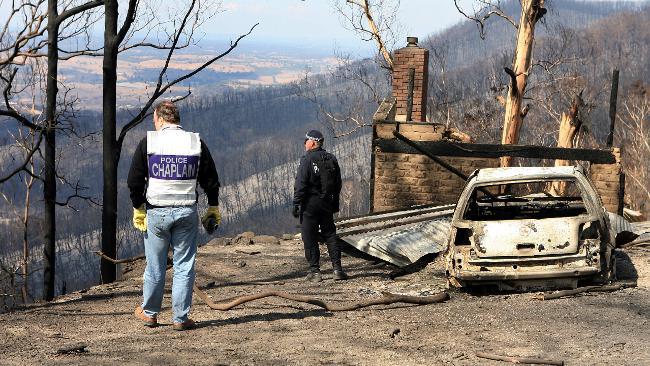Buyback lost behind political smokescreen

A key bushfire royal commission recommendation is being undermined
IT took only a few days before the sober and considered findings of Bernard Teague's Victorian bushfire royal commission were being undermined by politics and spin.
The 900-page report, based on 15 months of hearings, had barely been digested by John Brumby's government this week before it quietly set out to kill one of the commission's most challenging recommendations: that the state volunteer to buy back the properties of people living in areas of "unacceptably high" bushfire risk.
It was the recommendation the Brumby government had feared most, because it would be costly, complex and, above all, politically risky to implement only months before an election.
The government fears voters will see the idea as a kick in the guts for those country towns that have struggled back to their feet after the Black Saturday fires that claimed 173 lives across the state.
But the commission disagreed, arguing instead that governments in a bushfire-prone nation such as Australia have a duty of care to encourage people not to live in places that are only one blistering heat wave from becoming a death trap.
"The commission proposes that action be taken to help people move away from those areas and where other bushfire risk-mitigation measures are not viable . . . the state should develop and implement a voluntary retreat and resettlement strategy --including non-compulsory land acquisition -- for existing developments at unacceptably high bushfire risk," the report says.
If adopted, it would require the Victorian government to identify streets and individual properties around the state it deems to be of extreme risk from bushfire, and offer to buy back those properties, thereby giving people the voluntary option of an economic escape from the danger zone
Such a move would also have national implications, forcing other states to consider whether they also owe a greater duty of care to people living in places of extreme bushfire risk.
It is a proposal that raises basic questions about the balance between big government and civil liberties.
It places limits on Australia's cherished embrace of life in the bush and concedes that people cannot be trusted to consider their own safety when choosing where they live.
But is such a plan possible or practical on a statewide basis?
Brumby's official position is that his government will not make a final decision on the retreat and resettlement recommendation for several weeks, until it consults with communities in bushfire zones.
But behind the scenes, the government is trying to scuttle the idea. Government advisers have been on the phones to media warning the commissioners' plan would include vast numbers of homes and billions of dollars.
A report in the Herald Sun that was attributed to government sources warned that up to 49,000 houses would potentially have to be bought out at a cost of $15 billion to the taxpayer.
No explanation was given as to how these government figures were calculated.
Brumby also claims he has already received negative community feedback about the buyback proposal.
"There are certainly some people who would support this policy," Brumby tells Inquirer. "But the overwhelming majority views that I have had is that this would be very complex, very difficult, very expensive and would have implications that would lead to tens of thousands of homes and would lead to a lack of confidence in small towns right across country Victoria."
Brumby's comments sound less like those of the community than those of his own government lawyers, who told the commission in April that such a proposal would be "complex to deliver, extremely expensive, may increase bushfire risk and be potentially damaging to the communities affected".
The government's scare campaign on the issue has raised eyebrows among the commissioners, who used a press conference to point out that the proposed policy only applied to "micro-sites" rather than whole towns.
"They would be sites that are on ridge-lines, often surrounded by gullies . . . particularly if they are within 100m of bush," Susan Pascoe, one of the three commissioners, said.
In other words, the number of houses affected by the recommendation, and therefore the cost, would be substantially less than the government was claiming.
"I have been appalled by the government's reaction, which amounts to a gross exaggeration of the scale and the cost of what the commission was proposing,' says Michael Buxton, associate professor of environment and planning at RMIT, who was a member of the expert panel advising the commission.
"It would cost millions, rather than billions, and would only focus on very high-risk areas. It was never meant to be widely applied or to close whole towns down," Buxton says.
Because the government does not want the proposal to win wide public support, it is interpreting the commissioners' proposal in the widest possible manner to highlight the costs and complexities.
While the government refuses to disclose how it has costed the idea, it appears to have used as its basis a 2009 Country Fire Authority assessment that there are 52 "high risk zones" across the state, including highly populated areas such as the Dandenong Ranges and popular holiday towns such as Lorne.
Buxton says he believes the commission intended for the criteria to be much narrower, aiming at selected individual homes and streets rather than entire towns.
The example given in the final report was Pine Ridge Road, which runs along a mountain top in Kinglake West, where 21 people died on Black Saturday.
Buxton says such specific sites for buybacks would have only a minimal impact on country towns and that it was a scare tactic for the government to claim entire towns would die.
"Country towns have been dying in Victoria for all sorts of reasons, such as changes in manufacturing policy or agriculture," he says.
"Having a responsible bushfire policy would have only a minimal impact on these towns compared with those other factors."
But the commission did not provide a formula to determine what constitutes unacceptable bushfire risk and it did not give any examples of locations beyond Pine Ridge Road and parts of the town of Marysville.
According to the government, the devil lies in this detail.
The government would have the difficult task of determining the criteria for which homes qualify for a buyback and then it would have to apply it across the state.
But assessing bushfire risk is an imperfect science and the subjective nature of such a ruling on someone's home may open the door to numerous legal challenges.
Former forest fire chief Athol Hodgson says he is not surprised by the political posturing around the issue, saying this it has all happened before.
He says buybacks of land had been suggested in Victoria after bushfires in the 1960s and then after Ash Wednesday in the 80s.
The Liberal government did successfully implement a buyback of land in the Dandenong Ranges in the 70s but the Labor government had rejected similar ideas in other parts of the state in the 80s.
"It involves freedom of choice of where to live and that is opposed by some people. So it only works if you can make it work politically," Hodgson says.
"It's a very tricky issue to resolve. If people live in these areas and don't take some pretty drastic management to reduce their fire risk, there is no way authorities can ensure their safety."
Buxton believes that any decision to reject the commissioners' buyback proposal would represent a failure of leadership.
"The [Liberal Rupert] Hamer government in the 70s succeeded in limiting houses in the Dandenongs by building community support for the idea.
"What Brumby is doing is trying to scare people -- there is a stark contrast in leadership styles."
Opposition Leader Ted Baillieu, who has committed to implement the retreat and resettlement proposal if elected, says Brumby is grossly exaggerating the impact of the planned buyback.
"I see this as a modest recommendation rather than the sky is going to fall in and everyone [who lives in the bush] will have to leave their properties," he tells Inquirer.
The commissioners' report advocates a dual path of offering to buy back property while also placing restrictions on developing new properties deemed to be in extreme bushfire risk zones.
Planning expert Roslynne Hansen told the royal commission that tree change and sea change trends would see more people moving to small rural properties on the outskirts of Melbourne and that "more detailed consideration needs to be given to the strategic aspects of planning for bushfire attack".
Buxton agrees.
"Tens of thousands of people will move into these rural areas in the future and the government has to look at this issue carefully," he says.
"If it does not, then it will enormously increase risks for many thousands of people."
At its heart, the statewide retreat and resettlement proposal challenges the government to open a historic new chapter in Australian bushfire policy, ending the random nature of bush settlements.
Yet it appears to be doomed by politics even before it is properly considered.


